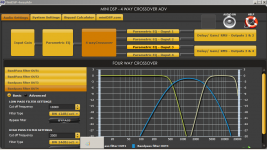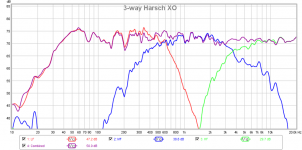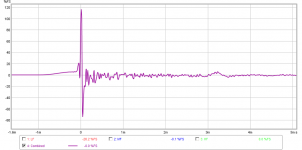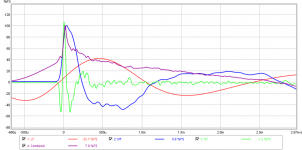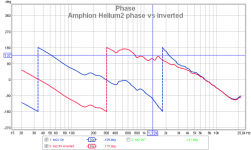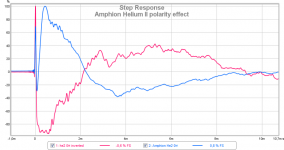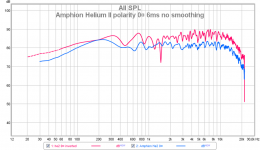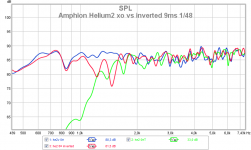This work started in the Filler Driver thread. I was studying transient XO's and built a test bed speaker to quickly test out new XO ideas with miniDSP. Here is a photo of my test bed. It is a basic open baffle for ease of construction and has a pair of Eminence Beta 12cx (no CD, with coax horn sealed up), a pair of PRV 5MR450NDY mids, and a PRV D280Ti with a PRV 45x45 deg waveguide. These are all fairly efficient drivers and are what I had on hand. The amp is provided by TDA7498 100w class D amps powered by 19v (mid and tweet) and 24v (woofers) SMPS bricks.
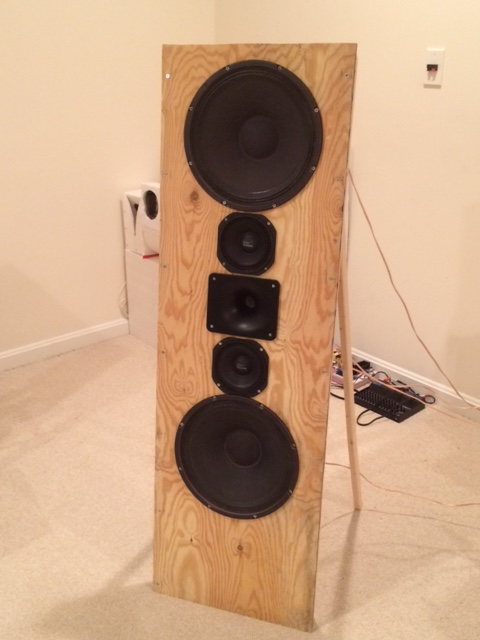
I first started with the B&O XO which requires a wide bandwidth mid that is band pass filtered with 1st order Butterworth and straddled on either side with a LR2 filter for the woofers and tweeter. I was then turned onto the XO topology proposed by Samuel Harsch by member Phase_Accurate. The paper is in French but I figured out that the basics are:
1. Set the low pass filter for the woofer as a 4th order Butterworth at central frequency, fc for the XO centerpoint.
2. Set the high pass filter for the tweeter as a 2nd order Bessel at fc.
3. Set the delay of the tweeter equal to 1/2 of the period of one cycle at fc.
4. Use all positive phase on woofer and tweeter.
Here is an example of the XO plot from the Harsch paper:
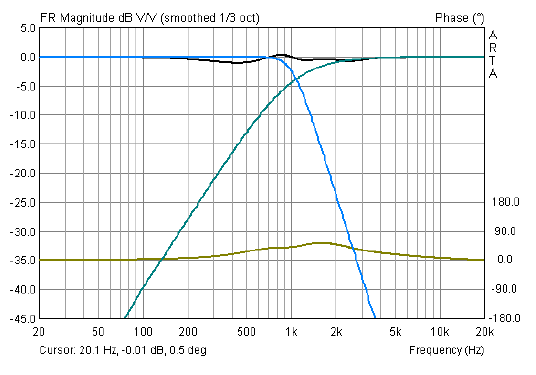
Here is the step function from the above XO as predicted by Harsch:
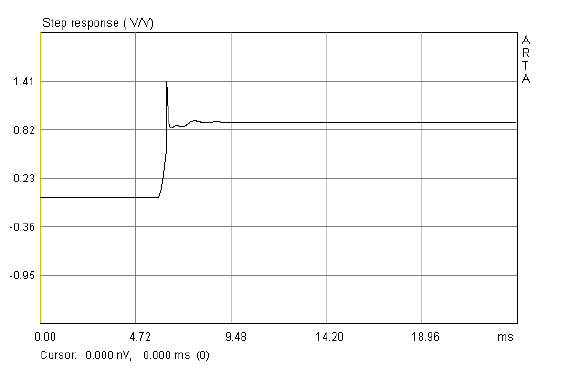
So I tried it out on my 2-way 10F/8424 & RS225-8 FAST Ref Monitors and got this for the XO plot:
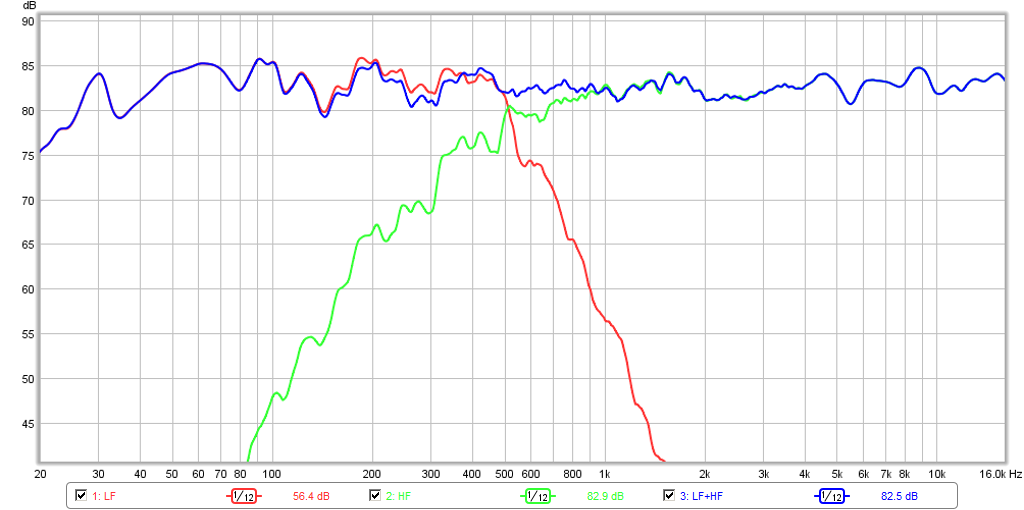
For the 10F/RS225 FAST, this was the corresponding measured Step Response:
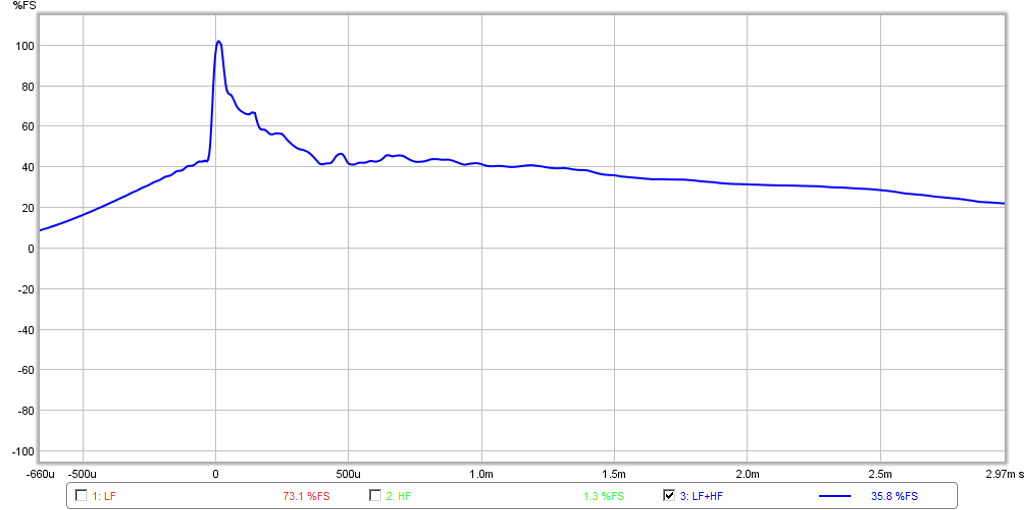
For the 10F/RS225 FAST, here was the measured phase (notice the little bump at the XO frequency as predicted - but no wrap):
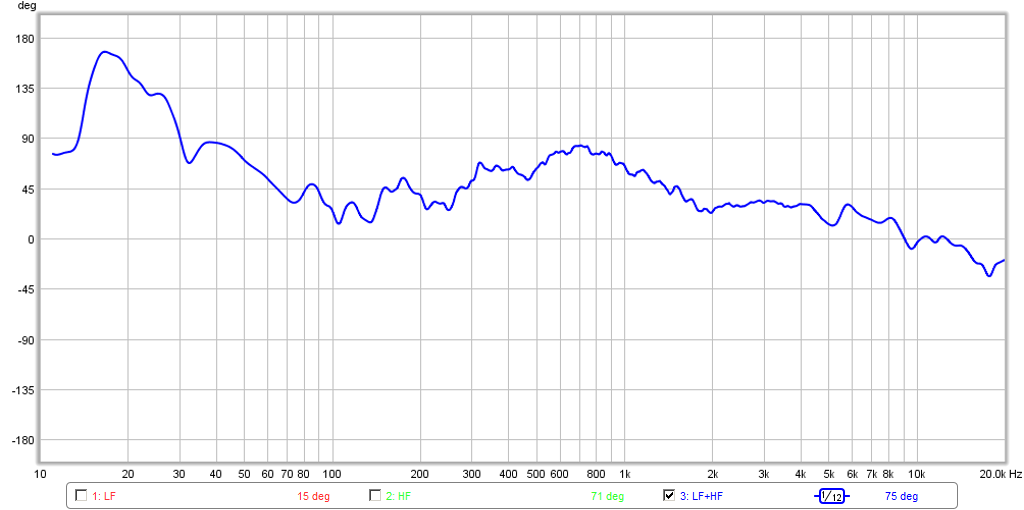
For the 10F/RS2225 FAST, here was the measured group delay, not over 5ms above 40Hz:
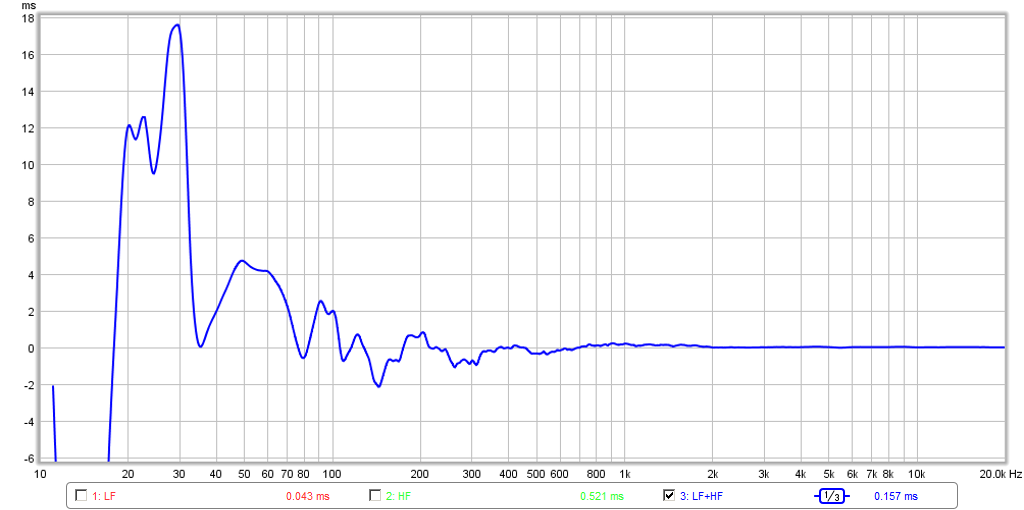
What the Harsch XO does nicely is that it allows one to use a steep XO to block out the nasty cone breakup on a woofer with a high order filter. Yet still not have a large phase wrap in order to maintain a time aligned transient perfect response.
So I got to thinking if this can be applied to a 3-way by mirroring the XO topology. That is Butterworth 4th order for the low pass on the woofer, Bessel 2nd order for the mid high pass and Bessel 2nd order for the mid low pass (or Bessel 2nd order bandpass for mid), and a Butterworth 4th order for the tweeter high pass. So what this means is that pretty generic components can be used in that a special wide band mid is not required anymore as the filter is already a fairly steep 2nd order. And for the woofer and tweeter, we can use 4th order filters which are great for controlling distortion, and preventing cone breakup leak-thru from the woofer.
As I had a 3-way XO test bed already handy, it was just a matter of putting the XO settings into miniDSP. So here is the electrical XO I implemented in miniDSP:
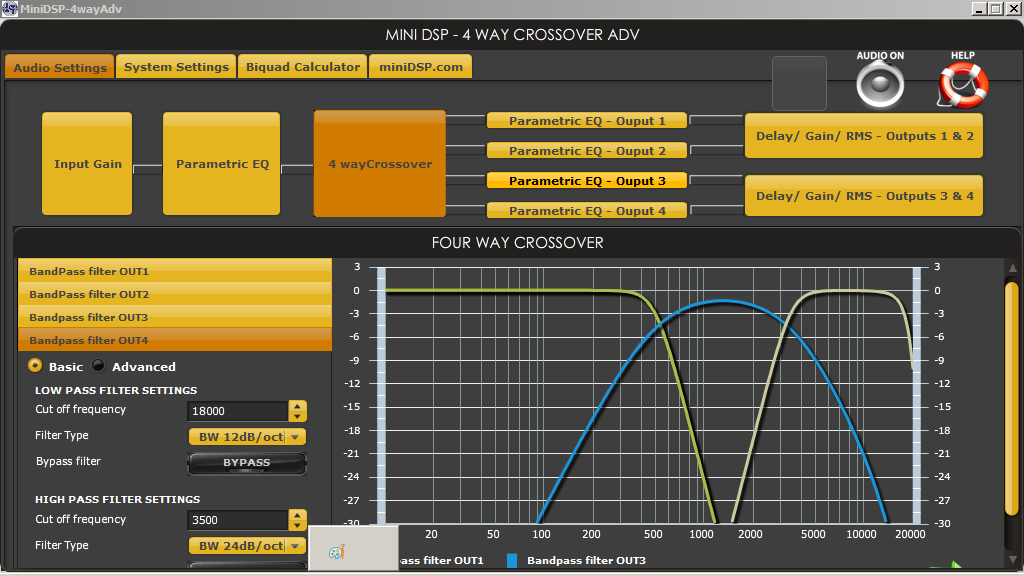
And here is the resulting acoustic XO that was measured (yes the SPL levels are fairly low so that I did not wake up the family during sweeps). As you can see, the curves are fairly common and innocuous. The 1st order textbook curves of the B&O were especially hard to achieve in practice. With the Harsch topology 2nd order and 4th order are much easier to get. The tricky thing is what to do for the time delays? Well, it is exactly the same delay assuming driver acoustic centers are already time aligned. The mid needs to be delayed from the woofer by 0.5/fc_low and the tweeter needs to be delayed from the mid by 0.5/fc_high. For my case, I used a 500Hz and 3500Hz XO points:
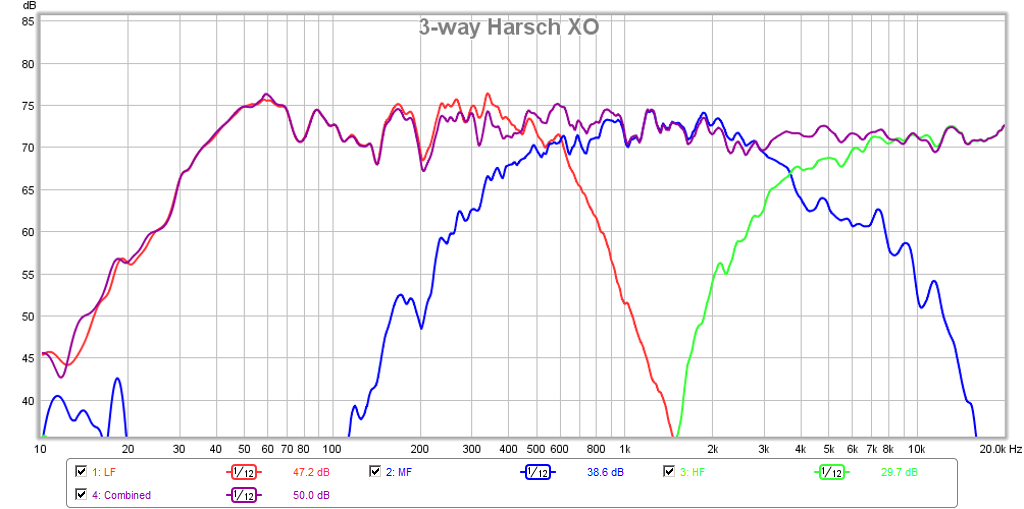
Here is the resulting Impulse Response:
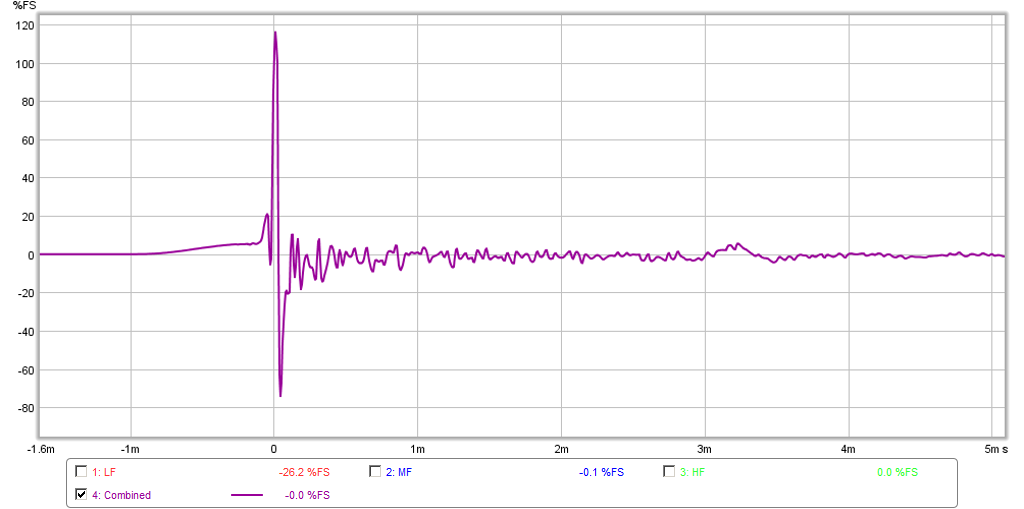
And here are the resulting Step Responses - I know there is a little pre-rise but overall it is much better than a jumbled up-down-up-down mess you would see with an all LR2 or LR4 XO:
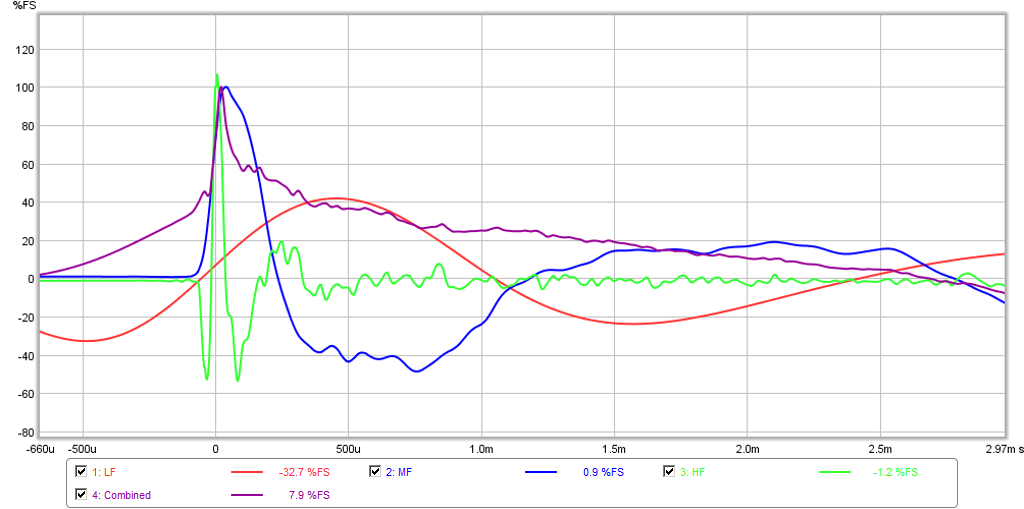
This is still a work in progress. Does anyone see any problems with it? I think this works. I am still having a problem getting the phase to be wrap free - it seems to wrap at the centeral frequency and not at the low and high XO frequencies. Anyhow, still debugging it. This XO may be useful for folks looking for an easy to implement quasi-transient perfect XO using IIR filters in DSP. How does it sound? Fantastic! My speakers are essentially 98dB sensitive and super loud and clean with this XO. I am really enjoying the sound and how the percussive sounds like guitar and drums really have a "live" feel to them.
Attached are some sound clips (stereo recording using Zoom H4 of the mono- Right channel playing). Change file extension from .asc to .mp3 in order to listen.

I first started with the B&O XO which requires a wide bandwidth mid that is band pass filtered with 1st order Butterworth and straddled on either side with a LR2 filter for the woofers and tweeter. I was then turned onto the XO topology proposed by Samuel Harsch by member Phase_Accurate. The paper is in French but I figured out that the basics are:
1. Set the low pass filter for the woofer as a 4th order Butterworth at central frequency, fc for the XO centerpoint.
2. Set the high pass filter for the tweeter as a 2nd order Bessel at fc.
3. Set the delay of the tweeter equal to 1/2 of the period of one cycle at fc.
4. Use all positive phase on woofer and tweeter.
Here is an example of the XO plot from the Harsch paper:

Here is the step function from the above XO as predicted by Harsch:

So I tried it out on my 2-way 10F/8424 & RS225-8 FAST Ref Monitors and got this for the XO plot:

For the 10F/RS225 FAST, this was the corresponding measured Step Response:

For the 10F/RS225 FAST, here was the measured phase (notice the little bump at the XO frequency as predicted - but no wrap):

For the 10F/RS2225 FAST, here was the measured group delay, not over 5ms above 40Hz:

What the Harsch XO does nicely is that it allows one to use a steep XO to block out the nasty cone breakup on a woofer with a high order filter. Yet still not have a large phase wrap in order to maintain a time aligned transient perfect response.
So I got to thinking if this can be applied to a 3-way by mirroring the XO topology. That is Butterworth 4th order for the low pass on the woofer, Bessel 2nd order for the mid high pass and Bessel 2nd order for the mid low pass (or Bessel 2nd order bandpass for mid), and a Butterworth 4th order for the tweeter high pass. So what this means is that pretty generic components can be used in that a special wide band mid is not required anymore as the filter is already a fairly steep 2nd order. And for the woofer and tweeter, we can use 4th order filters which are great for controlling distortion, and preventing cone breakup leak-thru from the woofer.
As I had a 3-way XO test bed already handy, it was just a matter of putting the XO settings into miniDSP. So here is the electrical XO I implemented in miniDSP:

And here is the resulting acoustic XO that was measured (yes the SPL levels are fairly low so that I did not wake up the family during sweeps). As you can see, the curves are fairly common and innocuous. The 1st order textbook curves of the B&O were especially hard to achieve in practice. With the Harsch topology 2nd order and 4th order are much easier to get. The tricky thing is what to do for the time delays? Well, it is exactly the same delay assuming driver acoustic centers are already time aligned. The mid needs to be delayed from the woofer by 0.5/fc_low and the tweeter needs to be delayed from the mid by 0.5/fc_high. For my case, I used a 500Hz and 3500Hz XO points:

Here is the resulting Impulse Response:

And here are the resulting Step Responses - I know there is a little pre-rise but overall it is much better than a jumbled up-down-up-down mess you would see with an all LR2 or LR4 XO:

This is still a work in progress. Does anyone see any problems with it? I think this works. I am still having a problem getting the phase to be wrap free - it seems to wrap at the centeral frequency and not at the low and high XO frequencies. Anyhow, still debugging it. This XO may be useful for folks looking for an easy to implement quasi-transient perfect XO using IIR filters in DSP. How does it sound? Fantastic! My speakers are essentially 98dB sensitive and super loud and clean with this XO. I am really enjoying the sound and how the percussive sounds like guitar and drums really have a "live" feel to them.
Attached are some sound clips (stereo recording using Zoom H4 of the mono- Right channel playing). Change file extension from .asc to .mp3 in order to listen.
Attachments
Last edited:
Is xover frequency in your 10F/RS225 at 700Hz ? I'm guessing yes because the peak of phase bump is located there.
Great stuff Xrk. I'm using nanoDIGI so this will help a lot. Harsch method seems legit.
Do you have any measurements off axis in vertical plane ? I'd like to see at what angle the lobing starts.
Great stuff Xrk. I'm using nanoDIGI so this will help a lot. Harsch method seems legit.
Do you have any measurements off axis in vertical plane ? I'd like to see at what angle the lobing starts.
Is xover frequency in your 10F/RS225 at 700Hz ? I'm guessing yes because the peak of phase bump is located there.
Great stuff Xrk. I'm using nanoDIGI so this will help a lot. Harsch method seems legit.
Do you have any measurements off axis in vertical plane ? I'd like to see at what angle the lobing starts.
On the 10F/RS225 inset electrical XO at 400Hz. The acoustic is about 500Hz. Yes, I see the bump at 700Hz too and that moves around with delay. I optimize delay for best SR not to place bump at XO freq. I have not taken any vertical polars yet. Will get to it one of these days.
I checked your thread about 10F/RS225. Your work is great and well documented as always 
I've listened two FAST speakers in past year and both had phase wrap at xover frequency and sounded quite strange - though they were a lot inferior in design than 10F/RS225 you've built. Similar concept but with 6.5" bass and 3" FR. Sounded ok at low levels though.
Anyway, me subscribed
I've listened two FAST speakers in past year and both had phase wrap at xover frequency and sounded quite strange - though they were a lot inferior in design than 10F/RS225 you've built. Similar concept but with 6.5" bass and 3" FR. Sounded ok at low levels though.
Anyway, me subscribed
I checked your thread about 10F/RS225. Your work is great and well documented as always
I've listened two FAST speakers in past year and both had phase wrap at xover frequency and sounded quite strange - though they were a lot inferior in design than 10F/RS225 you've built. Similar concept but with 6.5" bass and 3" FR. Sounded ok at low levels though.
Anyway, me subscribed
Zvu,
Thanks for the kind words. When phase wraps occur, the spatial imaging etc can be harder to get right. Do you have a thread somewhere showing your 6.5in x 3in FAST?
Can you share details of how you are using nanoDIGI? Like what DAC's are you using and how critical is it to have good DAC's? I found some SPDIF DAC's using Cirrus Logic chips. It has these components:
Cirrus Logic CS8416 192kHz low jitter digital receiver for SPDIF or AES/EBU
http://www.cirrus.com/en/pubs/proDatasheet/CS8416_F3.pdf
Cirrus Logic
CS4344-CZZR 24bit stereo 192kHz DAC
http://www.mouser.com/ds/2/76/CS4344-45-48_F2-472818.pdf
SE8117T33 3.3v voltage regulator
Is this any good? I can get these fully built for $10ea. Or does one really need to spend more?
Also, what are you using for the ADC or are you driving directly with digital from SPDIF on your PC? Or USB to SPDIF converter?
Thanks.
X
Last edited:
Interesting.
Something I'd like to see is a variant on this theme, where the tweeter gets a higher order filter than a 2nd order, which only maintains constant excursion as frequency decreases. Fine for home HiFi, but I'm mostly interested in playing with PA systems, so that last bit of power handling counts.
Could you use a 2nd order Bessel on the woofer and a 4th order Butterworth on the woofer for similar results?
I'd also be very interested to see a direct comparison between this and an all LR4 setup, if it'd be easy to do. I'm running LR4 everywhere at the moment.
TIA
Chris
Something I'd like to see is a variant on this theme, where the tweeter gets a higher order filter than a 2nd order, which only maintains constant excursion as frequency decreases. Fine for home HiFi, but I'm mostly interested in playing with PA systems, so that last bit of power handling counts.
Could you use a 2nd order Bessel on the woofer and a 4th order Butterworth on the woofer for similar results?
I'd also be very interested to see a direct comparison between this and an all LR4 setup, if it'd be easy to do. I'm running LR4 everywhere at the moment.
TIA
Chris
Interesting.
Something I'd like to see is a variant on this theme, where the tweeter gets a higher order filter than a 2nd order, which only maintains constant excursion as frequency decreases. Fine for home HiFi, but I'm mostly interested in playing with PA systems, so that last bit of power handling counts.
Could you use a 2nd order Bessel on the woofer and a 4th order Butterworth on the woofer for similar results?
I'd also be very interested to see a direct comparison between this and an all LR4 setup, if it'd be easy to do. I'm running LR4 everywhere at the moment.
TIA
Chris
The tweeter is indeed 4th order Butterworth here in the 3-way. That is why it is so convenient and practical. As a 2-way it has to be 2nd order, but by making 3-way the 2nd order is for the mid band pass.
.....I am still having a problem getting the phase to be wrap free.....
Great idea X try this XO type for three way system, regarding the phase problem try the relative same filter slopes for mid to tweeter as from woofer to mid and see phase you look for
Woofer low pass BW4 500Hz
Mid high pass BSL2 500Hz
Mid delayed total sum (physical plus electric) 1,0mSec.
Mid low pass BW4 4000Hz
Tweeter high pass BSL2 4000Hz
Tweeter delayed total sum (physical plus electric) 0,125mSec but add 1,0mSec as mid was delayed to woofer so total 1,125mSec.
Zvu,
Thanks for the kind words. When phase wraps occur, the spatial imaging etc can be harder to get right. Do you have a thread somewhere showing your 6.5in x 3in FAST?
Can you share details of how you are using nanoDIGI? Like what DAC's are you using and how critical is it to have good DAC's? I found some SPDIF DAC's using Cirrus Logic chips. It has these components:
Cirrus Logic CS8416 192kHz low jitter digital receiver for SPDIF or AES/EBU
http://www.cirrus.com/en/pubs/proDatasheet/CS8416_F3.pdf
Cirrus Logic
CS4344-CZZR 24bit stereo 192kHz DAC
http://www.mouser.com/ds/2/76/CS4344-45-48_F2-472818.pdf
SE8117T33 3.3v voltage regulator
Is this any good? I can get these fully built for $10ea. Or does one really need to spend more?
Also, what are you using for the ADC or are you driving directly with digital from SPDIF on your PC? Or USB to SPDIF converter?
Thanks.
X
It was not mine speakers or design. Drivers were visaton 170 AL and B-80. I just listened them and liked them at quite low listening levels midfield, but with normal listening levels they didn't sound very good to me. That's not to say that that are bad drivers but just that they needed a bit more work on the xover to make them sound better.
I didn't use any AD conversion with nanoDIGI. I am working with digital signal only. Notebook or desktop/TeralinkX2/nanoDIGI/AK4396/AMPs. With desktop it is direct SPDIF to nanoDIGI and with Notebook it is TeralinkX2. Friend gave me to test M2Tech HiFace but i didn't try it yet.
I have 3 converters AK4396 of which two are functional at the moment. NE5532 is left out and i've been using LT1364 instead with just few adjustments. I manage to do with just two dacs at the moment because speakers are sort of a hybrid. I have Beyma 15K200 for bass and using it with small two way on top. Xover between bass and mid is done by nanoDIGI. Small two way uses Seas CA12RCY and Morel CAT308. I did use Seas 19TFF1 tweeter in the small two way before with xover frequency at about 4KHz (just to try ProAc Tablette kind of sound) but i liked the sound of Morel and lower xover frequency (arround 2.2KHz) better.
But it is all temporary - except of Beyma of course. I found the bass i like, a just play with mid/tweet combinations when ever i can
Last edited:
Great idea X try this XO type for three way system, regarding the phase problem try the relative same filter slopes for mid to tweeter as from woofer to mid and see phase you look forexample:
Woofer low pass BW4 500Hz
Mid high pass BSL2 500Hz
Mid delayed total sum (physical plus electric) 1,0mSec.
Mid low pass BW4 4000Hz
Tweeter high pass BSL2 4000Hz
Tweeter delayed total sum (physical plus electric) 0,125mSec but add 1,0mSec as mid was delayed to woofer so total 1,125mSec.
My mic is at 1m and I think floor bounce or other reflections must be cause of phase wraps - I can count 10 phase wraps centered at 1.1kHz and I know the sound is coherent and not delayed 10 cycles (10ms) due to good IR and SR.
I forgot it is hard to get phase wrap free measurements when floor bounce potential is there.
Zvu,
Is it this build by vulejov you listened LINK: http://www.diyaudio.com/forums/full-range/193934-visaton-b80-6.html#post4123773.
Is it this build by vulejov you listened LINK: http://www.diyaudio.com/forums/full-range/193934-visaton-b80-6.html#post4123773.
Is this the same method as jmlc quasi optimal crossover posted somewhere
I don't know, I am not familiar with JMLC xo. Do you have a link?
X, great work as always, but I'm not convinced that there are benefits to having flatter phase. Have you done any testing that suggests you can hear the difference between perfectly flat phase and phase changes introduced by, say, LR4 crossovers? Look at rePhase. It will allow you to play with such things.
Most of the differences that people hear in different crossover topologies come from differences in the on- and off-axis frequency response.
Most of the differences that people hear in different crossover topologies come from differences in the on- and off-axis frequency response.
X, great work as always, but I'm not convinced that there are benefits to having flatter phase. Have you done any testing that suggests you can hear the difference between perfectly flat phase and phase changes introduced by, say, LR4 crossovers? Look at rePhase. It will allow you to play with such things.
Most of the differences that people hear in different crossover topologies come from differences in the on- and off-axis frequency response.
Thanks. I can hear a difference with guitar and drums and on-axis. Let me see if I can record sound clips of a speaker with the Harsch XO vs identical LR2 XO.
In the room listening - it is not subtle definitely can hear it.
It may be less obvious in a recording though but we will see. I will give you guys a blind listening test.
This kind of asymetric xo is an old trick. I ran to it when I measured my Amphion Helium IIs. It has like B2 for bass and LR4 for tweeter. I can't hear the difference! Here "inverted" is the factory default setting, it gives nice step response!
Attachments
Last edited:
- Home
- Loudspeakers
- Multi-Way
- S. Harsch XO
